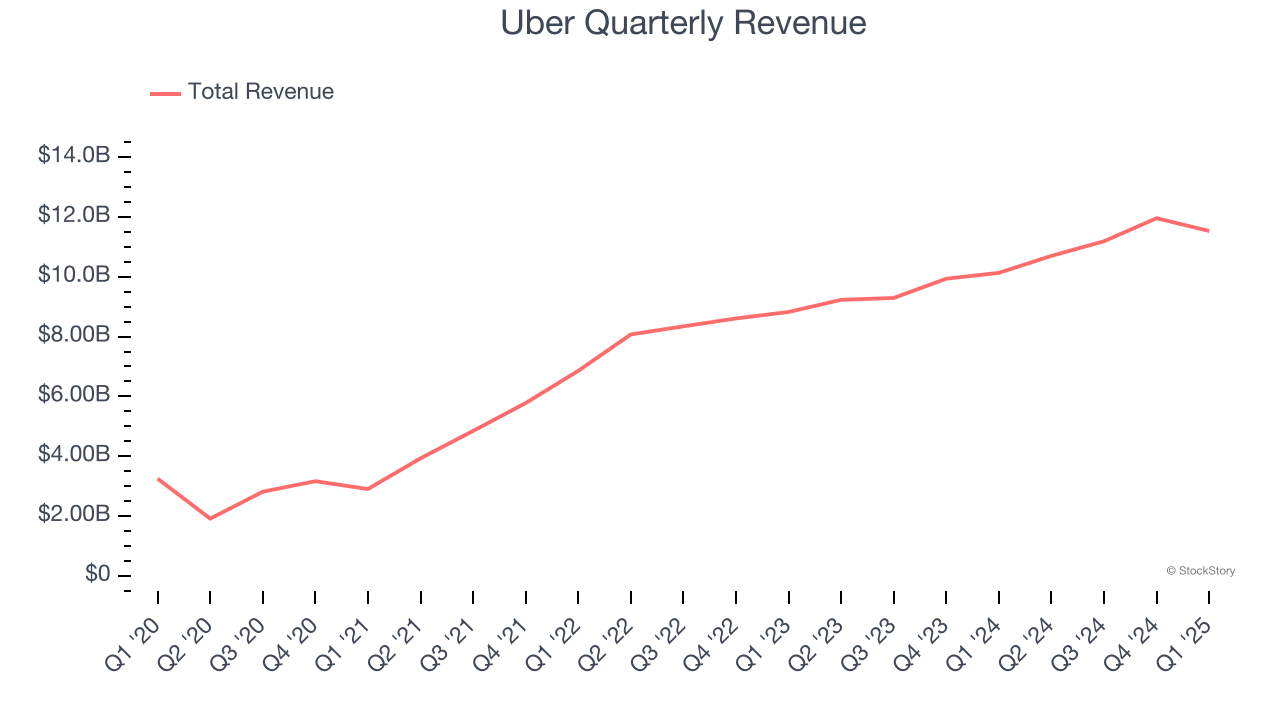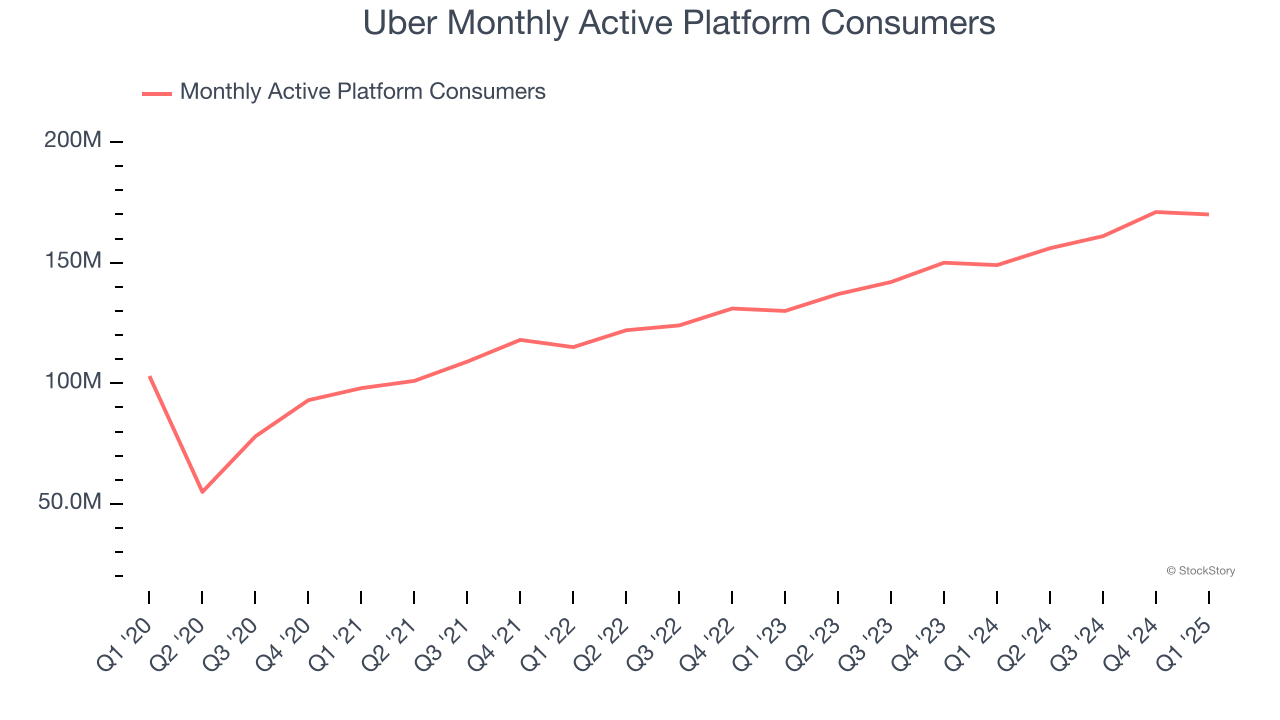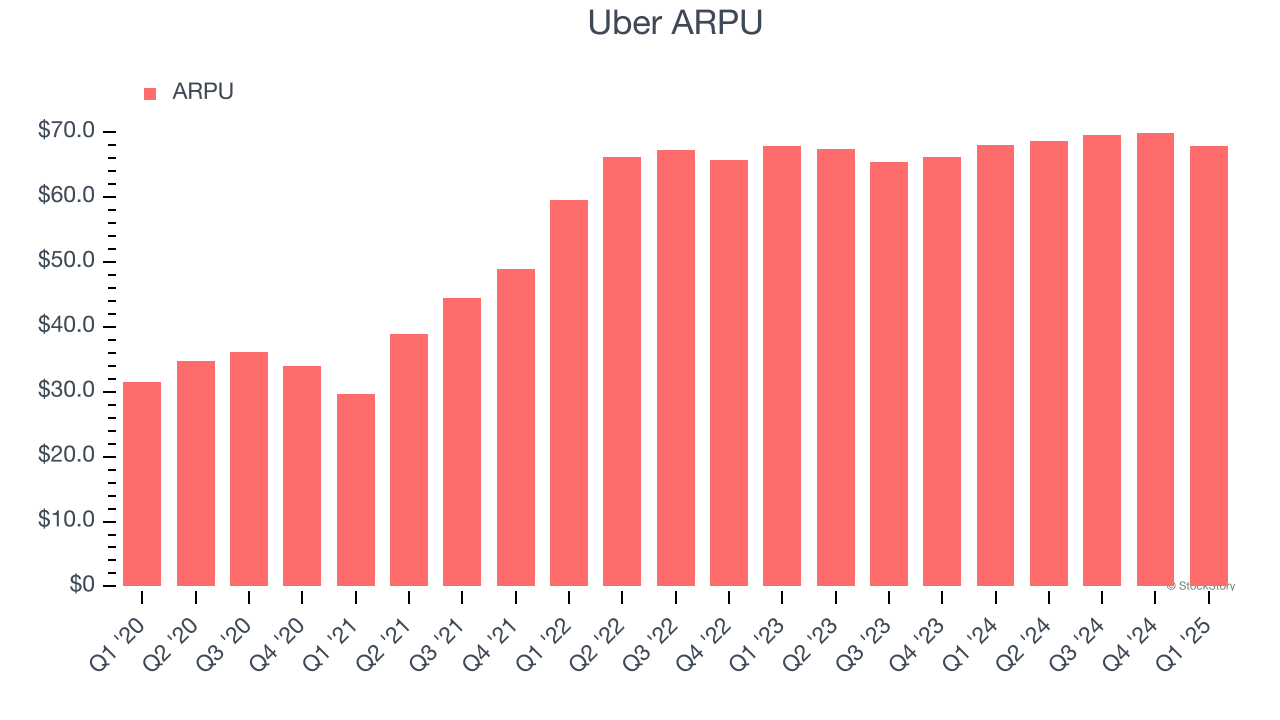
Ride sharing and on-demand delivery platform Uber (NYSE:UBER) met Wall Street’s revenue expectations in Q1 CY2025, with sales up 13.8% year on year to $11.53 billion. Its GAAP profit of $0.83 per share was 65% above analysts’ consensus estimates.
Is now the time to buy Uber? Find out by accessing our full research report, it’s free.
Uber (UBER) Q1 CY2025 Highlights:
- Gross Bookings: $42.8 billion vs analyst estimates of $43.0 billion (slight miss)
- Revenue: $11.53 billion vs analyst estimates of $11.59 billion (13.8% year-on-year growth, in line)
- EPS (GAAP): $0.83 vs analyst estimates of $0.50 (65% beat)
- Adjusted EBITDA: $1.87 billion vs analyst estimates of $1.84 billion (16.2% margin, 1.5% beat)
- Q2 2025 guidance: gross bookings and adjusted EBITDA guidance both beat slightly
- Operating Margin: 10.6%, up from 1.7% in the same quarter last year
- Free Cash Flow Margin: 19.5%, up from 14.3% in the previous quarter
- Monthly Active Platform Consumers: 170 million, up 21 million year on year
- Market Capitalization: $179.5 billion
“We kicked off the year with yet another quarter of profitable growth at scale, with trips up 18% and even stronger user retention,” said Dara Khosrowshahi, CEO.
Company Overview
Notoriously funded with $7.7 billion from the Softbank Vision Fund, Uber (NYSE:UBER) operates a platform of on-demand services such as ride-hailing, food delivery, and freight.
Sales Growth
A company’s long-term sales performance can indicate its overall quality. Any business can put up a good quarter or two, but the best consistently grow over the long haul. Thankfully, Uber’s 28.5% annualized revenue growth over the last three years was exceptional. Its growth surpassed the average consumer internet company and shows its offerings resonate with customers, a great starting point for our analysis.

This quarter, Uber’s year-on-year revenue growth was 13.8%, and its $11.53 billion of revenue was in line with Wall Street’s estimates.
Looking ahead, sell-side analysts expect revenue to grow 14.9% over the next 12 months, a deceleration versus the last three years. We still think its growth trajectory is attractive given its scale and indicates the market is baking in success for its products and services.
Today’s young investors won’t have read the timeless lessons in Gorilla Game: Picking Winners In High Technology because it was written more than 20 years ago when Microsoft and Apple were first establishing their supremacy. But if we apply the same principles, then enterprise software stocks leveraging their own generative AI capabilities may well be the Gorillas of the future. So, in that spirit, we are excited to present our Special Free Report on a profitable, fast-growing enterprise software stock that is already riding the automation wave and looking to catch the generative AI next.
Monthly Active Platform Consumers
User Growth
As a gig economy marketplace, Uber generates revenue growth by expanding the number of services on its platform (e.g. rides, deliveries, freelance jobs) and raising the commission fee from each service provided.
Over the last two years, Uber’s monthly active platform consumers, a key performance metric for the company, increased by 13.9% annually to 170 million in the latest quarter. This growth rate is among the fastest of any consumer internet business and indicates its offerings have significant traction. 
In Q1, Uber added 21 million monthly active platform consumers, leading to 14.1% year-on-year growth. The quarterly print isn’t too different from its two-year result, suggesting its new initiatives aren’t accelerating user growth just yet.
Revenue Per User
Average revenue per user (ARPU) is a critical metric to track because it measures how much the company earns in transaction fees from each user. This number also informs us about Uber’s take rate, which represents its pricing leverage over the ecosystem, or "cut" from each transaction.
Uber’s ARPU growth has been subpar over the last two years, averaging 1.7%. This isn’t great, but the increase in monthly active platform consumers is more relevant for assessing long-term business potential. We’ll monitor the situation closely; if Uber tries boosting ARPU by taking a more aggressive approach to monetization, it’s unclear whether users can continue growing at the current pace. 
This quarter, Uber’s ARPU clocked in at $67.84. It was flat year on year, worse than the change in its monthly active platform consumers.
Key Takeaways from Uber’s Q1 Results
It was great to see Uber increase its number of users this quarter. We were also happy its EBITDA outperformed Wall Street’s estimates. On the other hand, its gross bookings and revenue both missed slightly. Overall, this quarter could have been better. The stock traded down 3.9% to $82.50 immediately following the results.
Should you buy the stock or not? When making that decision, it’s important to consider its valuation, business qualities, as well as what has happened in the latest quarter. We cover that in our actionable full research report which you can read here, it’s free.
